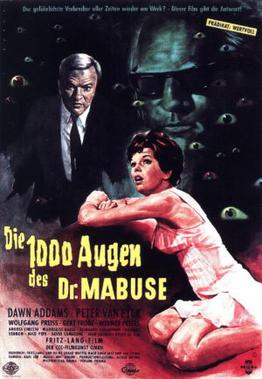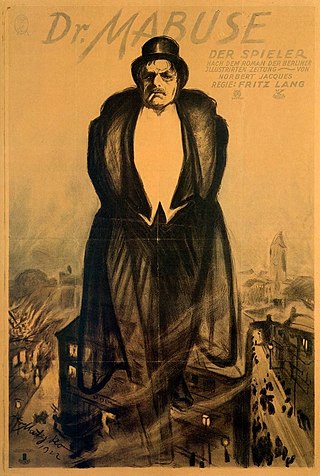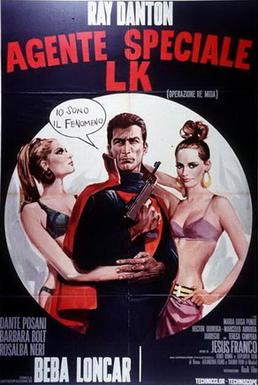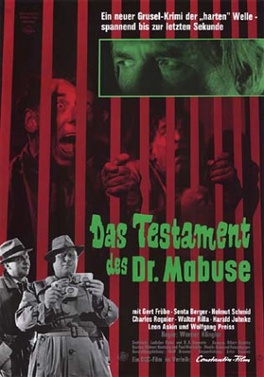
Friedrich Christian Anton Lang, better known as Fritz Lang, was an Austrian-born German-American film director, screenwriter, and producer who worked in Germany and later the United States. One of the best-known émigrés from Germany's school of Expressionism, he was dubbed the "Master of Darkness" by the British Film Institute. He has been cited as one of the most influential filmmakers of all time.

Dr. Mabuse is a fictional character created by Norbert Jacques in his 1921 novel Dr. Mabuse, der Spieler, and his 1932 follow-up novel Das Testament des Dr. Mabuse (1932). The character was made famous by three films about the character directed in Germany by Fritz Lang: Dr. Mabuse the Gambler, The Testament of Dr. Mabuse (1933), and the much later The Thousand Eyes of Dr. Mabuse (1960). Five other films featuring Dr. Mabuse were made by other directors in Germany in the early 1960s, followed by Jess Franco's interpretation The Vengeance of Dr. Mabuse in 1971.

The Testament of Dr. Mabuse, also called The Last Will of Dr. Mabuse, is a 1933 German crime-thriller film directed by Fritz Lang. The movie is a sequel to Lang's silent film Dr. Mabuse the Gambler (1922) and features many cast and crew members from Lang's previous films. Dr. Mabuse is in an insane asylum where he is found frantically writing his crime plans. When Mabuse's criminal plans begin to be implemented, Inspector Lohmann tries to find the solution with clues from gangster Thomas Kent, the institutionalized Hofmeister and Professor Baum who becomes obsessed with Dr. Mabuse.
Ewa Strömberg, was a Swedish actress. She appeared in a number of Swedish films before her international career. She is possibly best known for her appearance in a number of films by Spanish director Jesús "Jess" Franco, most notably Vampyros Lesbos (1971). She retired from the film industry shortly afterwards.

The Thousand Eyes of Dr. Mabuse is a 1960 black-and-white crime thriller film directed by Fritz Lang in his final film. A West German/French/Italian international co-production, it starred Peter van Eyck, Dawn Addams and Gert Fröbe. The film made use of the character Dr. Mabuse, who had appeared in earlier films by Lang in 1922 and 1933. The Thousand Eyes of Dr. Mabuse spawned a film series of German Mabuse films that were released over the following years to compete with Rialto Film's Krimi films.

Dr. Mabuse the Gambler is the first film in the Dr. Mabuse series about the character Doctor Mabuse who featured in the novels of Norbert Jacques. It was directed by Fritz Lang and released in 1922. The film is silent and would be followed by the sound sequels The Testament of Dr. Mabuse (1933) and The Thousand Eyes of Dr. Mabuse (1960).

The Awful Dr. Orloff is a 1962 Spanish-French horror film written and directed by Jesús Franco. It stars Howard Vernon as the mad Dr. Orloff who wants to repair his disfigured daughter's face with skin grafts from other women with the aid of a slavish, blind henchman named Morpho. A co-production between Spain and France, filmed in Madrid, the film is considered to be the earliest Spanish horror film.

She Killed in Ecstasy is a 1971 West German-Spanish erotic thriller film directed by Jesús Franco. The film's plot borrows elements from previous Franco films Miss Muerte and Venus in Furs. The film's productions staff includes many cast members and nearly the same crew as his previous film Vampyros Lesbos.

Artur "Atze" Brauner was a German film producer and entrepreneur of Polish origin. He produced more than 300 films from 1946.

Faceless is a 1988 French horror film directed by Jesús Franco. The film stars Helmut Berger as Dr. Flamand, Brigitte Lahaie as Nathalie, Christopher Mitchum as Sam Morgan, and Stéphane Audran. In the film, Dr. Flamand and his assistant Nathalie lure unsuspecting victims to use their skin to perform plastic surgery on the doctor's disfigured sister. A New York businessman hires private detective Sam Morgan to find his missing fashion model daughter.

Norbert Jacques was a Luxembourgish novelist, journalist, screenwriter, and translator who wrote in German. He was born in Luxembourg-Eich, Luxembourg and died in Koblenz, West Germany. He created the character Dr. Mabuse, who was a feature of some of his novels. Dr. Mabuse, der Spieler, the first novel to feature Mabuse, was one of the bestsellers of its time; it sold over 500,000 copies in Germany. Today, Jacques is known best for Dr. Mabuse. In 1922, he received German citizenship.

A Virgin Among the Living Dead is a film directed by Jesús Franco. Franco shot the film in Portugal in 1971 with the film it was only being released to the public in 1973. While credited as a production of Liechtenstein, it was submitted theatrically as being the product of various countries with Franco biographer suggesting that the Prodif Ets. company was set up as a tax shelter.

Lucky, the Inscrutable is a 1967 spy film directed by Jesús Franco and starring Ray Danton.
Roberto Camardiel Escudero was a Spanish theatre director and actor.
Gustavo Re was a Spanish television presenter and actor.
Fénix Cooperativa Cinematográfica is a Spanish production company based in Madrid known for The Lady Doctor (1958).

The Testament of Dr. Mabuse is a 1962 German film directed by Werner Klingler. It was the fourth part of the Dr. Mabuse series from the 1960s and was a remake of the 1933 Fritz Lang film The Testament of Dr. Mabuse.
The following is a list of unproduced Jesús Franco projects in roughly chronological order. During his long career, Spanish film director Jesús Franco has worked on a number of projects which never progressed beyond the pre-production stage under his direction.

Vampiresas 1930 (volando hacia la fama) (transl. Female Vamps 1930 – Flying to Fame) is a 1961 Spanish musical comedy film directed by Jesús Franco. The film is about two musicians, Tony who gets the attention of a silent film star and Daniel who falls for a dancer. The four work together until they find themselves out of work and begin performing as a jazz band. The four suddenly get caught up in a murder racket, that was actually committed by a two gangsters who run the casino that the four play at.













